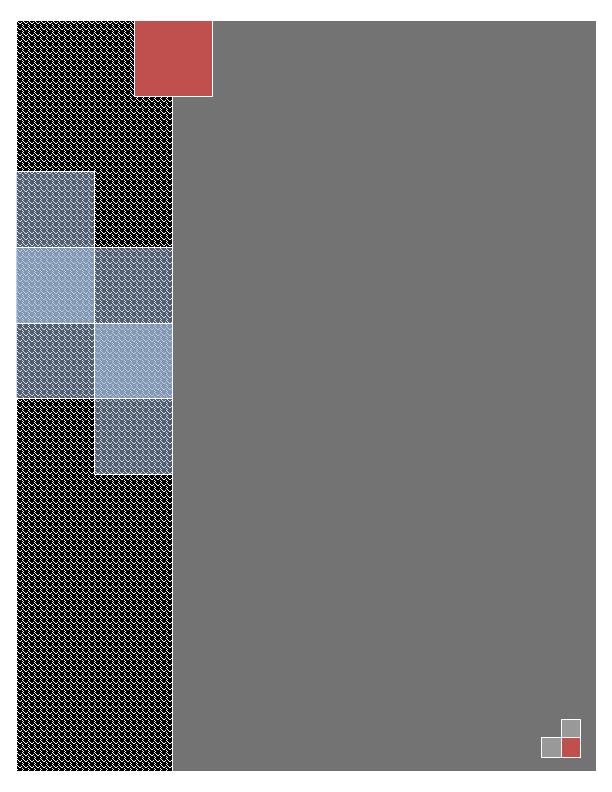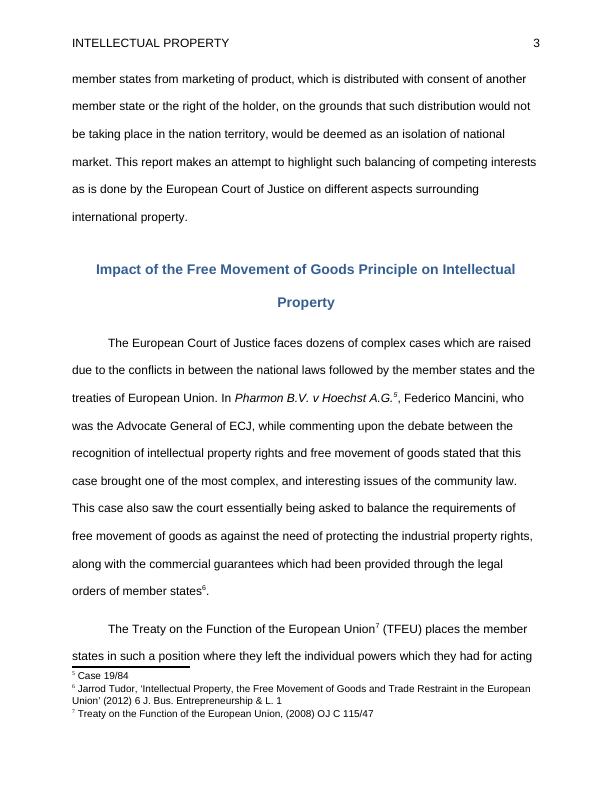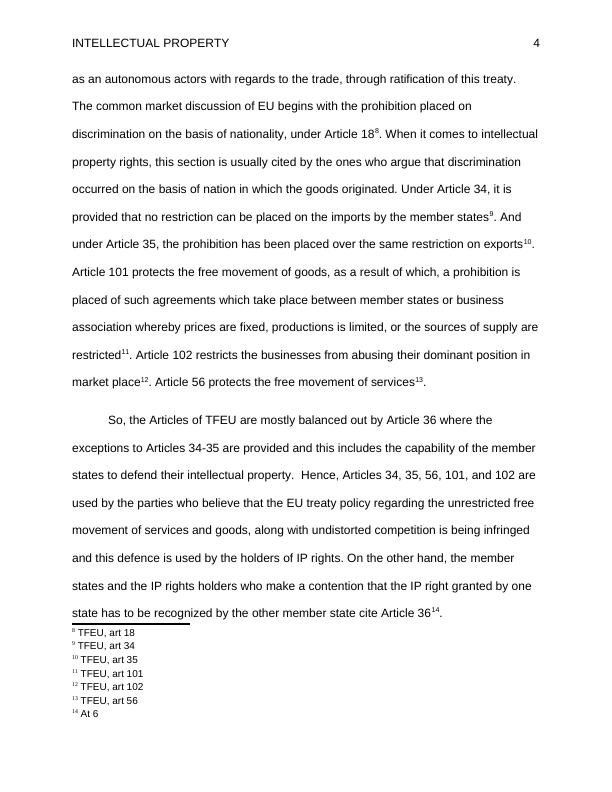International Intellectual Property Law Group Report
Added on 2020-04-01
16 Pages3750 Words31 Views

INTELLECTUAL PROPERTY 2
Introduction
Intellectual property can be best defined as the creations of mind for instance the
innovations or inventions, the artistic work, designs, names, images and symbols,
amongst the various other creations. The intellectual property law regulates these very
creations, their use and the exploitation of creative or mental labour1. There are different
type of intellectual property, which includes patents, trademarks and copyrights; yet,
each kind has one common factor, which is the protection of this intangible property,
i.e., of the information, invention, ideas and signs. As these are not tangible property,
their parameters of boundary are defined by their own technique, for instance, the
registration technique or the scheme or deposit. Intellectual property remains a
politicised issue due to some sides claiming that there is an inadequacy in the law to
protect the intellectual property right holders and the other claiming the opposite2.
The European Union laws also have an impact over the intellectual property
laws, particularly based on the harmonization of laws of member states, the move
towards a community wide intellectual property rights and the impact of the treaties of
EU on the use, as well as, abuse of these rights3. The statement made in Deutsche
Grammophon v Metro4 shows the manner in which the European Court balances the
competing interests’ by combining the treaty obligations. This case dealt with the
prohibition that where a right which relates to a copyright is relied for preventing the
1 Lionel Bently and Brad Sherman, Intellectual Property Law (4th edn, Oxford University Press 2014)
2 Tanya Frances Aplin and Jennifer Davis, Intellectual Property Law: Text, Cases, and Materials (3rd edn,
Oxford University Press 2017)
3 Charlotte Waelde, Abbe Brown, Jane Cornwell and Smita Kheria, Contemporary Intellectual Property:
Law and Policy (4th edn, Oxford University Press 2016)
4 [1971] ECR 487
Introduction
Intellectual property can be best defined as the creations of mind for instance the
innovations or inventions, the artistic work, designs, names, images and symbols,
amongst the various other creations. The intellectual property law regulates these very
creations, their use and the exploitation of creative or mental labour1. There are different
type of intellectual property, which includes patents, trademarks and copyrights; yet,
each kind has one common factor, which is the protection of this intangible property,
i.e., of the information, invention, ideas and signs. As these are not tangible property,
their parameters of boundary are defined by their own technique, for instance, the
registration technique or the scheme or deposit. Intellectual property remains a
politicised issue due to some sides claiming that there is an inadequacy in the law to
protect the intellectual property right holders and the other claiming the opposite2.
The European Union laws also have an impact over the intellectual property
laws, particularly based on the harmonization of laws of member states, the move
towards a community wide intellectual property rights and the impact of the treaties of
EU on the use, as well as, abuse of these rights3. The statement made in Deutsche
Grammophon v Metro4 shows the manner in which the European Court balances the
competing interests’ by combining the treaty obligations. This case dealt with the
prohibition that where a right which relates to a copyright is relied for preventing the
1 Lionel Bently and Brad Sherman, Intellectual Property Law (4th edn, Oxford University Press 2014)
2 Tanya Frances Aplin and Jennifer Davis, Intellectual Property Law: Text, Cases, and Materials (3rd edn,
Oxford University Press 2017)
3 Charlotte Waelde, Abbe Brown, Jane Cornwell and Smita Kheria, Contemporary Intellectual Property:
Law and Policy (4th edn, Oxford University Press 2016)
4 [1971] ECR 487

INTELLECTUAL PROPERTY 3
member states from marketing of product, which is distributed with consent of another
member state or the right of the holder, on the grounds that such distribution would not
be taking place in the nation territory, would be deemed as an isolation of national
market. This report makes an attempt to highlight such balancing of competing interests
as is done by the European Court of Justice on different aspects surrounding
international property.
Impact of the Free Movement of Goods Principle on Intellectual
Property
The European Court of Justice faces dozens of complex cases which are raised
due to the conflicts in between the national laws followed by the member states and the
treaties of European Union. In Pharmon B.V. v Hoechst A.G.5, Federico Mancini, who
was the Advocate General of ECJ, while commenting upon the debate between the
recognition of intellectual property rights and free movement of goods stated that this
case brought one of the most complex, and interesting issues of the community law.
This case also saw the court essentially being asked to balance the requirements of
free movement of goods as against the need of protecting the industrial property rights,
along with the commercial guarantees which had been provided through the legal
orders of member states6.
The Treaty on the Function of the European Union7 (TFEU) places the member
states in such a position where they left the individual powers which they had for acting
5 Case 19/84
6 Jarrod Tudor, ‘Intellectual Property, the Free Movement of Goods and Trade Restraint in the European
Union’ (2012) 6 J. Bus. Entrepreneurship & L. 1
7 Treaty on the Function of the European Union, (2008) OJ C 115/47
member states from marketing of product, which is distributed with consent of another
member state or the right of the holder, on the grounds that such distribution would not
be taking place in the nation territory, would be deemed as an isolation of national
market. This report makes an attempt to highlight such balancing of competing interests
as is done by the European Court of Justice on different aspects surrounding
international property.
Impact of the Free Movement of Goods Principle on Intellectual
Property
The European Court of Justice faces dozens of complex cases which are raised
due to the conflicts in between the national laws followed by the member states and the
treaties of European Union. In Pharmon B.V. v Hoechst A.G.5, Federico Mancini, who
was the Advocate General of ECJ, while commenting upon the debate between the
recognition of intellectual property rights and free movement of goods stated that this
case brought one of the most complex, and interesting issues of the community law.
This case also saw the court essentially being asked to balance the requirements of
free movement of goods as against the need of protecting the industrial property rights,
along with the commercial guarantees which had been provided through the legal
orders of member states6.
The Treaty on the Function of the European Union7 (TFEU) places the member
states in such a position where they left the individual powers which they had for acting
5 Case 19/84
6 Jarrod Tudor, ‘Intellectual Property, the Free Movement of Goods and Trade Restraint in the European
Union’ (2012) 6 J. Bus. Entrepreneurship & L. 1
7 Treaty on the Function of the European Union, (2008) OJ C 115/47

INTELLECTUAL PROPERTY 4
as an autonomous actors with regards to the trade, through ratification of this treaty.
The common market discussion of EU begins with the prohibition placed on
discrimination on the basis of nationality, under Article 188. When it comes to intellectual
property rights, this section is usually cited by the ones who argue that discrimination
occurred on the basis of nation in which the goods originated. Under Article 34, it is
provided that no restriction can be placed on the imports by the member states9. And
under Article 35, the prohibition has been placed over the same restriction on exports10.
Article 101 protects the free movement of goods, as a result of which, a prohibition is
placed of such agreements which take place between member states or business
association whereby prices are fixed, productions is limited, or the sources of supply are
restricted11. Article 102 restricts the businesses from abusing their dominant position in
market place12. Article 56 protects the free movement of services13.
So, the Articles of TFEU are mostly balanced out by Article 36 where the
exceptions to Articles 34-35 are provided and this includes the capability of the member
states to defend their intellectual property. Hence, Articles 34, 35, 56, 101, and 102 are
used by the parties who believe that the EU treaty policy regarding the unrestricted free
movement of services and goods, along with undistorted competition is being infringed
and this defence is used by the holders of IP rights. On the other hand, the member
states and the IP rights holders who make a contention that the IP right granted by one
state has to be recognized by the other member state cite Article 3614.
8 TFEU, art 18
9 TFEU, art 34
10 TFEU, art 35
11 TFEU, art 101
12 TFEU, art 102
13 TFEU, art 56
14 At 6
as an autonomous actors with regards to the trade, through ratification of this treaty.
The common market discussion of EU begins with the prohibition placed on
discrimination on the basis of nationality, under Article 188. When it comes to intellectual
property rights, this section is usually cited by the ones who argue that discrimination
occurred on the basis of nation in which the goods originated. Under Article 34, it is
provided that no restriction can be placed on the imports by the member states9. And
under Article 35, the prohibition has been placed over the same restriction on exports10.
Article 101 protects the free movement of goods, as a result of which, a prohibition is
placed of such agreements which take place between member states or business
association whereby prices are fixed, productions is limited, or the sources of supply are
restricted11. Article 102 restricts the businesses from abusing their dominant position in
market place12. Article 56 protects the free movement of services13.
So, the Articles of TFEU are mostly balanced out by Article 36 where the
exceptions to Articles 34-35 are provided and this includes the capability of the member
states to defend their intellectual property. Hence, Articles 34, 35, 56, 101, and 102 are
used by the parties who believe that the EU treaty policy regarding the unrestricted free
movement of services and goods, along with undistorted competition is being infringed
and this defence is used by the holders of IP rights. On the other hand, the member
states and the IP rights holders who make a contention that the IP right granted by one
state has to be recognized by the other member state cite Article 3614.
8 TFEU, art 18
9 TFEU, art 34
10 TFEU, art 35
11 TFEU, art 101
12 TFEU, art 102
13 TFEU, art 56
14 At 6

End of preview
Want to access all the pages? Upload your documents or become a member.
Related Documents
International Intellectual Property Lawlg...
|18
|4244
|4
International Intellectual Property Law Assignmentlg...
|5
|934
|108
International Intellectual Property Lawlg...
|11
|3678
|2
European Union Law on Free Movementlg...
|11
|4071
|11
Intellectual Property Law in Internet Injunction Blocking: UK Trademark Caseslg...
|14
|3292
|228
The Concept of Supremacy and Direct Effect in European Lawlg...
|6
|1705
|320
